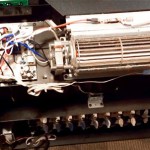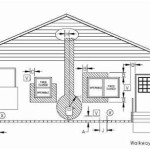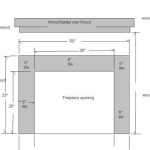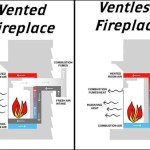Understanding Direct Vent Fireplace Inserts: A Comprehensive Guide
Direct vent fireplace inserts represent a significant advancement in home heating technology, offering a blend of aesthetics, efficiency, and safety. These inserts are designed to be installed within an existing masonry or factory-built fireplace, transforming an older, often inefficient, fireplace into a modern, effective heating appliance. This article delves into the mechanics, benefits, types, installation considerations, and maintenance aspects of direct vent fireplace inserts, providing a comprehensive understanding of this popular heating solution.
The core function of a direct vent insert is to provide supplemental heat to a specific area of the home, often the living room or family room. Unlike traditional open fireplaces, which can lose substantial heat up the chimney, direct vent systems are engineered to maximize heat output and minimize energy waste. This is achieved through a sealed combustion system and a dual-vent configuration that draws combustion air from outside the home and exhausts combustion byproducts directly outdoors.
The increasing popularity of direct vent inserts is attributable to several factors, including rising energy costs, heightened environmental awareness, and a desire for a convenient and aesthetically pleasing heating alternative. These inserts offer homeowners a controllable, efficient, and visually appealing way to supplement their existing heating systems and create a cozy and inviting atmosphere.
Key Point 1: The Mechanics of Direct Vent Systems
The defining characteristic of a direct vent fireplace insert is its sealed combustion system. This system operates independently of the home's interior air, relying instead on a dedicated air intake and exhaust vent. This configuration offers several advantages, including improved indoor air quality and enhanced energy efficiency.
The venting process involves two concentric or coaxial pipes. The inner pipe is used to exhaust combustion gases, such as carbon dioxide and water vapor, to the outside. The outer pipe simultaneously draws fresh air from the outside to support the combustion process within the firebox. This dual-pipe system effectively isolates the combustion process from the living space, preventing drafts and minimizing the risk of carbon monoxide poisoning.
The sealed firebox is another crucial component. This airtight enclosure prevents air leakage and ensures that all combustion gases are directed through the exhaust vent. This design significantly reduces the risk of backdrafting, a dangerous phenomenon where combustion gases are drawn back into the home. The sealed firebox also contributes to the overall efficiency of the insert by preventing heat loss through uncontrolled air movement.
Many direct vent inserts incorporate a fan or blower system to circulate heated air into the room. This forced-air circulation helps to distribute heat more evenly and effectively than radiant heat alone. The fan speed is typically adjustable, allowing homeowners to control the amount of heat distributed and the level of airflow within the room.
The burner system within the insert is designed for clean and efficient combustion. Modern direct vent inserts often feature advanced burner technology that optimizes fuel-to-air ratios, resulting in reduced emissions and improved fuel economy. The burner is typically fueled by natural gas or propane, offering a convenient and readily available energy source.
Key Point 2: Benefits of Direct Vent Fireplace Inserts
Direct vent fireplace inserts offer a multitude of benefits compared to traditional open fireplaces or other heating alternatives. These benefits extend beyond simple heat production, encompassing aspects of safety, efficiency, convenience, and aesthetics.
Enhanced Safety: The sealed combustion system is the primary safety feature, preventing the escape of dangerous combustion gases into the home. This eliminates the risk of carbon monoxide poisoning, a serious health hazard associated with improperly vented fireplaces. The sealed firebox also prevents sparks and embers from escaping, reducing the risk of fire.
Improved Energy Efficiency: Direct vent inserts are significantly more efficient than traditional fireplaces. Their sealed design prevents heat loss up the chimney, and the forced-air circulation system distributes heat more effectively throughout the room. This results in lower energy bills and reduced reliance on the home's central heating system.
Convenience and Ease of Use: These inserts require minimal maintenance compared to wood-burning fireplaces. There is no need to chop wood, haul ashes, or clean the chimney regularly. Many models feature remote controls and programmable thermostats, allowing homeowners to easily adjust the heat output and set desired temperature levels.
Aesthetic Appeal: Direct vent inserts are available in a wide range of styles and finishes, allowing homeowners to choose a model that complements their existing décor. Options include realistic log sets, decorative glass media, and various trim options. The visual appeal of a fireplace can significantly enhance the ambiance of a room, creating a cozy and inviting atmosphere.
Increased Home Value: Installing a direct vent fireplace insert can increase the value of a home. Buyers often appreciate the combination of aesthetics, efficiency, and convenience that these inserts offer. A well-maintained fireplace can be a significant selling point, particularly in colder climates.
Key Point 3: Types and Considerations for Choosing a Direct Vent Insert
Direct vent fireplace inserts are available in various configurations, fuel types, and heating capacities. Choosing the right insert requires careful consideration of factors such as the size of the room, the existing fireplace opening, and the homeowner's heating needs and preferences.
Fuel Type: The two primary fuel options are natural gas and propane. Natural gas inserts are typically connected to an existing natural gas line, offering a convenient and reliable fuel source. Propane inserts require a propane tank, which can be located outside the home. The choice between natural gas and propane often depends on the availability of natural gas service and the homeowner's specific needs.
Heating Capacity: The heating capacity of an insert is measured in British thermal units (BTUs). The appropriate BTU rating depends on the size of the room to be heated and the climate in which the home is located. A larger room or a colder climate will require an insert with a higher BTU rating. Consulting with a qualified HVAC professional can help determine the optimal BTU rating for a specific application.
Insert Size and Fit: Direct vent inserts are designed to fit within existing fireplace openings. It is crucial to measure the fireplace opening accurately and choose an insert that is compatible in size. Some inserts are designed for smaller fireplace openings, while others are better suited for larger openings. Professional installation often involves customizing the surround panels to ensure a seamless and aesthetically pleasing fit.
Venting Requirements: Direct vent inserts require a dedicated venting system that extends to the outside of the home. The venting system must be installed according to the manufacturer's instructions and local building codes. The vent can be installed horizontally through an exterior wall or vertically through the roof. The choice of venting configuration depends on the layout of the home and the location of the fireplace.
Aesthetic Preferences: Direct vent inserts are available in a wide range of styles and finishes. Consider the overall décor of the room and choose an insert that complements the existing style. Options include traditional log sets, modern glass media, and various trim options. The visual appeal of the insert can significantly enhance the ambiance of the room.
Installation Considerations: Professional installation by a qualified technician is highly recommended. A professional installer will ensure that the insert is properly installed, vented, and connected to the fuel supply. Proper installation is essential for safety, efficiency, and reliable operation. Building codes typically require inspections to ensure that the installation meets safety standards.
Maintenance and Care: Direct vent inserts require minimal maintenance compared to wood-burning fireplaces. However, regular inspections and cleaning are recommended to ensure optimal performance and safety. The burner should be inspected annually for any signs of damage or debris. The venting system should also be inspected to ensure that it is free of obstructions.
Direct vent fireplace inserts represent a significant investment in home comfort and energy efficiency. Selecting the right insert and ensuring proper installation and maintenance are crucial for maximizing the benefits and ensuring long-term satisfaction. The features offered by direct vent systems continue to develop, therefore, consulting with professionals and researching the latest models is advisable before making any purchase.

30 Ruby Contemporary Intellifire Touch Direct Vent Fireplace Insert Blower And Remote Electronic Ignition Majestic

White Mountain Hearth Rushmore Direct Vent Insert With Truflame Tech Fireplaces Usa

White Mountain Hearth By Empire Comfort Systems Direct Vent Gas Fireplace Insert Loft

Rushmore 30 Direct Vent Fireplace Insert Fine S Gas

25 Ruby Traditional Intellifire Touch Direct Vent Fireplace Insert Blower And Remote Electronic Ignition Majestic

Majestic Direct Vent Gas Fireplace Insert Jasper

Real Fyre Contemporary Direct Vent Insert Nashville Outdoor Kitchens Gas Grills Fireplaces

Majestic Ruby 35 Direct Vent Gas Insert Ruby35 North Country Fire

Top Direct Vent Gas Inserts In D C

Inserts Gas Kingsman Direct Vent Fireplace Insert Millivolt Natural Idv36n
Related Posts








